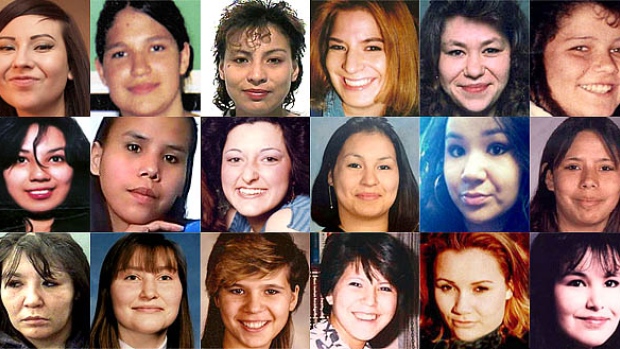
It was the data that got me. Not just the number of data points, but the shape of the data. The shape reminded me of a Holter monitor recording of a not-quite-right heart rate. Fitting, perhaps, as something definitely wasn’t right.

There is a person gone for each square. A person with friends, family, and a mystery. Each one was murdered or is missing. What happened to these nearly 300 Indigenous women and girls? This is the question that Connie Walker and her team at Canadian Broadcasting Corporation (CBC) News set out to answer with the series Missing & Murdered: The Unsolved Cases of Indigenous Women and Girls, started in 2015. The number of cases grows, but so does the attention paid. Finally.
Look at the date at the top left of the figure above. It took until August 2016 to get a government inquiry launched. That’s 2 years after the Royal Canadian Mounted Police released a report that said ~1,200 Indigenous women went missing or were murdered between 1980 and 2012. Twelve hundred. That’s over 3 dozen Indigenous women gone a year for 32 years. If those numbers shock you, prepare yourself. The Native Women’s Association of Canada says the number is ~4,000.
With numbers like these the individual can be lost. So let us start with just one – Alberta Williams. Who killed Alberta Williams? Learn about Alberta and her case in a podcast hosted by Connie Walker. Some questions will be answered, but more will be raised.
__________
Featured image is from CBC News





Those numbers are quite disturbing. I am assuming the numbers of missing women and girls is far greater than the number of missing men and boys, but I couldn’t find those figures in the source. Is this a matter of white, male police neglecting to investigate these cases, or is this a matter of indigenous women being targeted by killers?
A little from Column A, a little from Column B. (Though I should caution, don’t assume white women will be any more sympathetic. Sometimes they even run for president, touting a law states use to break up Indian families.)
This has actually been going on since before 1980. Actually that was a big reason Indians were so pissed about Custer’s Revenge.
In the States, there’s actually a court decision, Oliphant v. Suquamish Indian Tribe, which creates a whole jurisdictional vacuum for crimes committed by non-Indians on reservations.
I’ve been listening to the podcast and I’m suspecting in this case we have an acquaintance murder, but who knows? The podcast itself is giving so much insight on how a homicide like Alberta’s can go unsolved. The distrust of police being a big one. But the numbers point to a large issue itself. That many of the victims did not know their killer.
https://www.thestar.com/news/canada/2015/12/04/nearly-half-of-murdered-indigenous-women-did-not-know-killers-star-analysis-shows.html
Stranger perpetrators are often more difficult to catch. Also because there are many cases where the women were transient, homeless, or had other high risk lifestyle factors that make it difficult for police to even understand where they were before they went missing.
It’s a shameful part of our history and we are finally seeing amends. Yes it is largely in part to systemic racism and police bigotry. In Edmonton alone we had seen so many women murdered and nothing being done until Project Kare. Even still we have a lot to answer for.
http://www.theglobeandmail.com/news/investigations/probing-the-mystery-of-edmontons-killingfields/article31294565/
The history of indeginous Canadians and the government is a sad, twisted mess and is going to continue to reverberate for decades to come.
Thrill killers. They used to do something called “Injun rollin” (The n is alveolar, not velar, in that Red State dialect.) where they’d find a passed-out Indian (either drunk or simply sleeping homeless), wrap them in a blanket, drive them to the top of the cliff, and throw them off
A favorite of law enforcement is starlight tours, taking an Indian just outside of town (in the middle of a Manitoba winter) and letting him find his own way home.
I could keep giving examples. Yeah, it’s pretty nasty.
It’s hard to believe some people are human, sometimes.
Hey, welcome to our world. It’s why I have a different opinion on gun control than most people here. With a gun, or even the possibility of having a gun, we can defend ourselves. And these jokers are, well, Jokers: Sadistic killers whose only motive is their personal amusement.